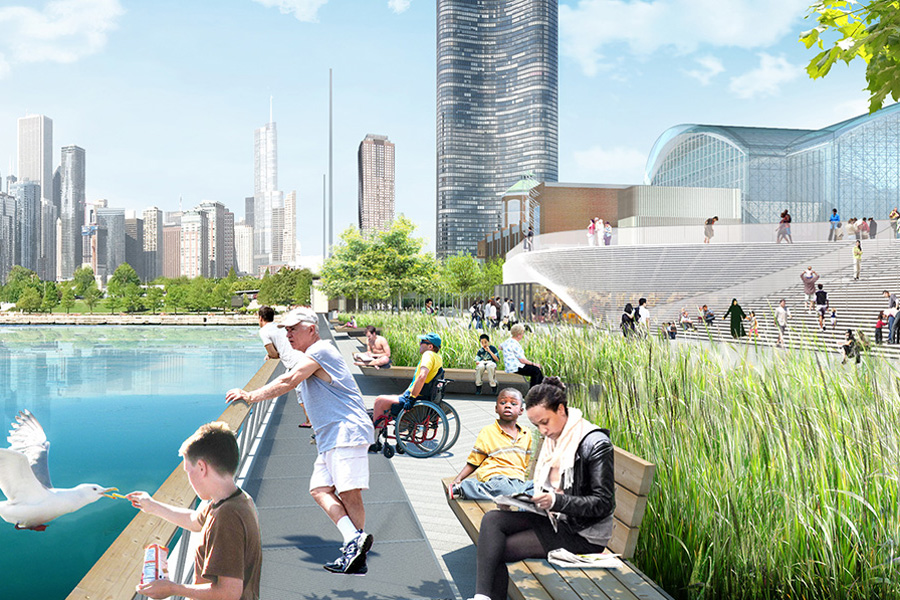Navy Pier, among city-dwellers, is something of a punchline: a theme park that is not a park and has no theme. As downtown's urban spaces, such as Millennium Park and Maggie Daley Park, have become more sophisticated and elaborate, Navy Pier's age shows—a training-wheels urbanism that dates back to when American cities were fitfully trying to attract suburbanites who'd abandoned them long ago.
About a year ago, Curbed Chicago's Aaron Dunlap vividly captured the paradox: an enormously popular tourist attraction that no one seems to like.
At a public presentation… updated plans were shown for the massive renovation project already underway to transform Navy Pier from the "carnival aesthetic" we've known for years…. The various speakers weren't shy about the current shortcomings of the Pier as it was redesigned in 1995 and exists today; it's too hard to get to, there's too much vehicle traffic near the entrance, there's not enough parking, there's not much to draw visitors to the eastern end, the interior feels like a shopping mall, Pier Park feels like a carnival, the food options don't reflect Chicago's culinary strengths. At times it felt like a Friars Club roast of the pier itself, but if these problems aren't acknowledged there's little hope of correcting them.
But we knew it was coming.
Last week I read some pieces by the late Tribune architecture writer Paul Gapp for a post about his run-in with Donald Trump; the aggro developer filed a nuisance lawsuit against Gapp, angered by his (well-informed and ultimately correct) prediction that Trump would never pull off building the world's tallest building.
And Gapp was also right about Navy Pier when he predicted that it would be DOA as an urban amenity; the current renovations are an attempt to address complaints lodged by Gapp well before the last ones were completed.
The last renovation was completed in 1995. Gapp wrote this in 1991:
Pier Authority and city officials speak of pedestrian walkways, landscaping, and other esthetic gestures as ways of minimizing the impact of commercializing the pier with stores, trade-show spaces, and other money-makers. Yet much of this talk is diversionary malarkey.
[snip]
Too many Chicago power people dream of a pier onto which would be jammed elements of San Francisco's Ghirardelli Square and Boston's Faneuil Hall. Too many politicians have been brainwashed into believing that big business can profoundly enhance the quality of urban life by converting old structures into pseudo-quaint profit-makers.
[snip]
Navy Pier is the last reasonably accessible downtown shoreline outpost not excessively devoted to the automobile, or to making money, but to such simple family or solo pleasures as strolling, bicycling, picnicking, listening to music, attending an ethnic festival or admiring superb views of the city.
(Even as early as 1987, Gapp had warned that businessmen were "bent on opening fern bars;" I'm not sure even he could have envisioned Margaritaville.)
And what Chicago got was… a bunch of elements of Faneuil Hall, which Blair Kamin termed "City Lite" and the Boston Globe's Robert Campbell called a "halfway house for suburbanites."
Then again, maybe that halfway house was needed at the time. When Benjamin Thompson, the architect behind Faneuil Hall, died, the New York Times memorialized his work: "…it is difficult now to recall how radical the notion once was that a dilapidated, moribund inner-city locale could be remade as a vibrant, popular, round-the-clock gathering place."
But Gapp wanted then what we're getting now. As far back as 1986, Gapp approved of a task force report in which "strollers, joggers, bicyclists, picknickers, fishermen and other lovers of simple pier pleasures would get immediate and prime consideration," along with "a few small and appropriate shops." His only fear was a parking garage on the Pier—"a totally unacceptable notion"—and not just because of the damage to Navy Pier itself: "the thought of new auto access ramps is terrifying because their design would be left to highway engineers who have already done far too much permanent visual damage to the area."
Two decades later, the city removed two lanes, extended the sidewalk, and is spending $60 million on a years-long project, the Navy Pier Flyover, to give the consideration back to the strollers, joggers, and bicyclists. When they get there, they'll find a "green spine" on the South Dock that "allows for a new physical connection between the lake and the city" with "locally-sourced trees."
One of Gapp's preferences remains largely shelved, though. In 1987, a task force from the National Park Service suggested a "three-foot-deep lagoon along the south side of the pier just off shore. This would be done by enclosing a small section of the lake with piers and causeways and filling in the bottom. Canoes and paddle boats would be available in the lagoon, which would serve ice skaters in the winter."
And when High Line co-designer James Corner won the bid to redo the pier, it included an enclosed, shallow lagoon along the south side of the pier, just offshore. The pool later got nixed for budgetary reasons, but it will get a fountain that doubles as an ice skating rink, in the expanded Polk Brothers Park just outside the pier.
Paul Gapp's critiques of Navy Pier were ahead of their time. Almost a decade before Navy Pier's conservative redesign in 1995, Gapp envisoned what it is becoming now. Perhaps 1995 would have been too soon, but today cities are confident enough in the appeal of the urban experience to throw off the facade of suburbia and let the cityscape speak for itself.



